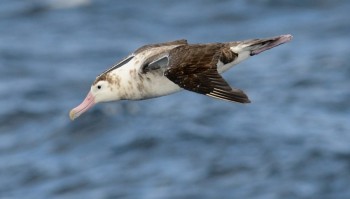
Yawning for the camera. A Tristan Albatross on Gough Island, photograph by Tom McSherry
To date, the Gough Island Restoration Programme (GIRP) has completed the first bait drop over the island to eradicate the island’s albatross-killing mice and is waiting for good weather to undertake the required second drop. In the interim researchers on the island have continued to monitor breeding by the Critically Endangered (and near-endemic) Tristan Albatross Diomedea dabbenena, as recently reported via the GIRP Facebook page.
“Our team just returned from two of our 11 Tristan Albatross monitoring sites– Gonydale and Tafelkop – and reported no nest failures since their last check! This is literally unheard of at this time of year. Even though we haven’t completed the second bait drop yet we can already get a sense of what life would be like on Gough without the mice.”
Watch a video as GIRP Researcher Michelle Risi imparts the news in front of a Tristan Albatross chick in the Tafelkop monitoring colony, first set up in the 1980s.
ACAP’s Information Officer has a particular interest in the fate of the Tristan Albatross on Gough. He set up both long-term study colonies - on Tafelkop in the 1980s and in Gonydale in the 2006/07 and 2007/08 breeding seasons - when all the occupied nests in the two localities were staked and breeding adults metal and colour-banded during incubation, with their surviving chicks metal banded later in the year. Monitoring has continued ever since with pairs of field workers being appointed on an annual basis.
Access the latest (No. 8, May 2021) and earlier editions of Island Restoration News, the GIRP newsletter here.
John Cooper, ACAP Information Officer, 26 July 2021

 English
English  Français
Français  Español
Español 



